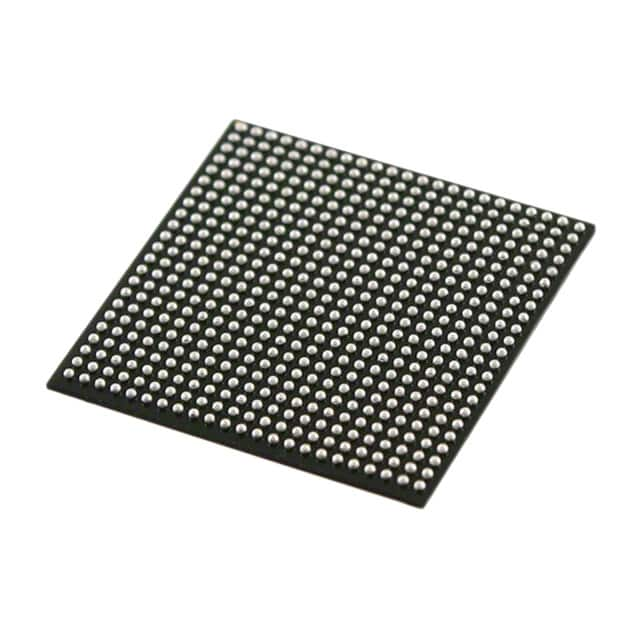5CGXFC4C6U19C7N
Product Overview
Category
The 5CGXFC4C6U19C7N belongs to the category of Field Programmable Gate Arrays (FPGAs).
Use
FPGAs are integrated circuits that can be programmed and reprogrammed to perform various digital functions. The 5CGXFC4C6U19C7N is specifically designed for high-performance applications that require complex logic functions.
Characteristics
- High-performance FPGA with advanced features
- Large capacity for complex designs
- Flexible and reprogrammable
- Low power consumption
- High-speed data processing capabilities
Package
The 5CGXFC4C6U19C7N comes in a compact package suitable for surface mount technology (SMT) assembly. It is available in a variety of package options, including ball grid array (BGA) and quad flat no-leads (QFN).
Essence
The essence of the 5CGXFC4C6U19C7N lies in its ability to provide a customizable hardware solution for complex digital systems. It allows designers to implement their own logic functions and algorithms, providing flexibility and adaptability.
Packaging/Quantity
The 5CGXFC4C6U19C7N is typically sold in reels or trays, depending on the package type. The quantity per reel or tray may vary, but it is commonly available in quantities suitable for both prototyping and production purposes.
Specifications
- Logic Elements: 4,600
- Embedded Memory: 1,638 Kbits
- Maximum User I/Os: 622
- Maximum User I/O Banks: 8
- Clock Networks: 16
- DSP Blocks: 96
- Maximum Internal Configuration Memory: 2,000 Kbits
- Operating Voltage: 1.2V
- Operating Temperature Range: -40°C to +100°C
Detailed Pin Configuration
The pin configuration of the 5CGXFC4C6U19C7N is as follows:
| Pin Name | Description | |----------|-------------| | VCCINT | Core voltage supply | | GND | Ground reference | | IOB[0:621] | User I/O pins | | CLK[0:15] | Clock input pins | | JTAGTCK, JTAGTMS, JTAGTDI, JTAGTDO, JTAGEN | JTAG interface pins | | CONFDONE, nSTATUS | Configuration status pins | | ... | (Additional pins as per specific package and configuration) |
Functional Features
- High-speed data processing capabilities
- Configurable logic elements for custom designs
- Embedded memory blocks for data storage
- Dedicated DSP blocks for efficient signal processing
- Flexible clock networks for precise timing control
- Support for various communication protocols
- Built-in configuration memory for easy reprogramming
Advantages and Disadvantages
Advantages
- Flexibility and adaptability for complex designs
- High-performance computing capabilities
- Low power consumption compared to traditional ASICs
- Shorter time-to-market due to reprogrammability
- Cost-effective for low to medium volume production
Disadvantages
- Higher cost compared to fixed-function integrated circuits
- Limited performance compared to application-specific solutions
- Requires specialized knowledge for effective utilization
- Design complexity increases with larger designs
Working Principles
The 5CGXFC4C6U19C7N works based on the principle of configurable logic. It consists of a matrix of programmable logic elements interconnected through configurable routing resources. These logic elements can be programmed to implement various digital functions, such as arithmetic operations, data manipulation, and control logic. The configuration memory stores the user-defined logic functions, which can be loaded during startup or reprogrammed as needed.
Detailed Application Field Plans
The 5CGXFC4C6U19C7N finds applications in various fields, including:
- Telecommunications: Used for high-speed data processing in network infrastructure equipment.
- Aerospace and Defense: Employed in radar systems, avionics, and secure communication systems.
- Industrial Automation: Enables complex control algorithms in robotics, motor control, and process automation.
- Medical Devices: Utilized for real-time signal processing in medical imaging and diagnostics.
- Automotive: Supports advanced driver assistance systems (ADAS) and infotainment systems.
Detailed and Complete Alternative Models
- 5CGXFC4C7U23C8N
- 5CGXFC4C6U23C8N
- 5CGXFC4C6U23I7N
- 5CGXFC4C6U23I7LN
- 5CGXFC4C6U23I7LNL
Lista 10 Vanliga frågor och svar relaterade till tillämpningen av 5CGXFC4C6U19C7N i tekniska lösningar
Sure! Here are 10 common questions and answers related to the application of 5CGXFC4C6U19C7N in technical solutions:
Q: What is the 5CGXFC4C6U19C7N FPGA used for? A: The 5CGXFC4C6U19C7N FPGA is commonly used for implementing complex digital logic circuits in various technical solutions.
Q: What are the key features of the 5CGXFC4C6U19C7N FPGA? A: The key features include a high-density programmable logic fabric, embedded memory blocks, high-speed transceivers, and support for various I/O standards.
Q: How can the 5CGXFC4C6U19C7N FPGA be programmed? A: The FPGA can be programmed using hardware description languages (HDLs) such as VHDL or Verilog, or through graphical programming tools like Quartus Prime.
Q: What applications can benefit from using the 5CGXFC4C6U19C7N FPGA? A: The FPGA can be used in applications like telecommunications, industrial automation, video processing, medical devices, and many more that require high-performance digital signal processing or complex control logic.
Q: What is the maximum number of logic elements available in the 5CGXFC4C6U19C7N FPGA? A: The 5CGXFC4C6U19C7N FPGA has a maximum of 115,200 logic elements, which can be used to implement complex digital circuits.
Q: Does the 5CGXFC4C6U19C7N FPGA support high-speed serial communication? A: Yes, the FPGA includes high-speed transceivers that support various protocols like PCIe, Gigabit Ethernet, and Serial RapidIO.
Q: Can the 5CGXFC4C6U19C7N FPGA interface with external memory devices? A: Yes, the FPGA has embedded memory blocks and supports various external memory interfaces like DDR3, DDR4, and QDR II+.
Q: What is the power consumption of the 5CGXFC4C6U19C7N FPGA? A: The power consumption depends on the specific design and utilization of the FPGA, but it typically ranges from a few watts to tens of watts.
Q: Is the 5CGXFC4C6U19C7N FPGA suitable for low-power applications? A: While the FPGA is not specifically designed for low-power applications, power optimization techniques can be applied to reduce its power consumption.
Q: Are there any development boards available for prototyping with the 5CGXFC4C6U19C7N FPGA? A: Yes, Intel (formerly Altera) provides development boards like the Arria V GX Starter Kit, which includes the 5CGXFC4C6U19C7N FPGA, allowing users to prototype their designs.
Please note that the specific details and answers may vary depending on the context and requirements of the technical solution.


